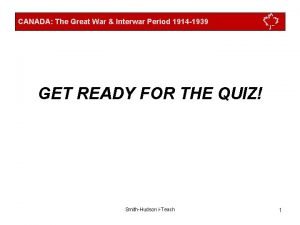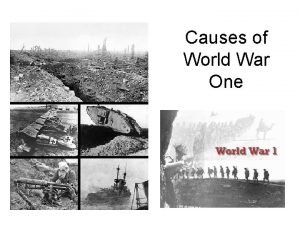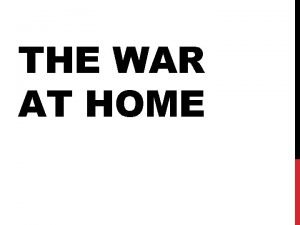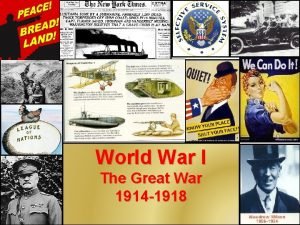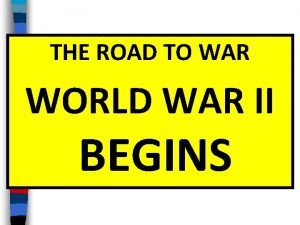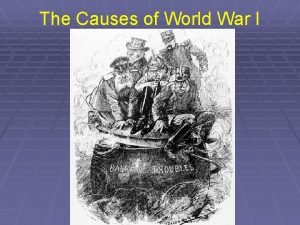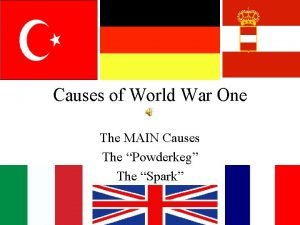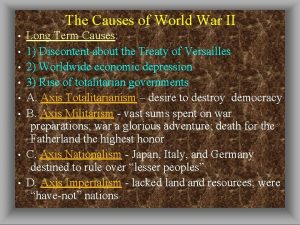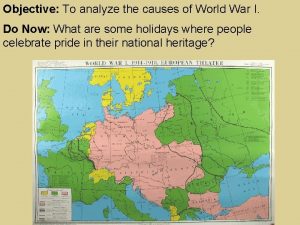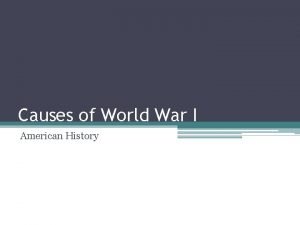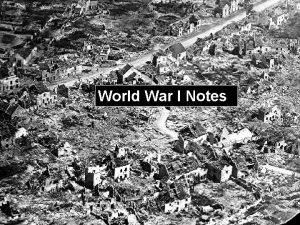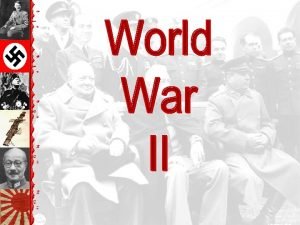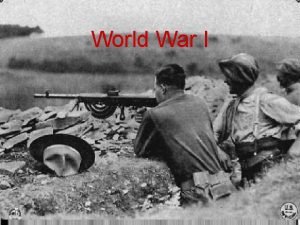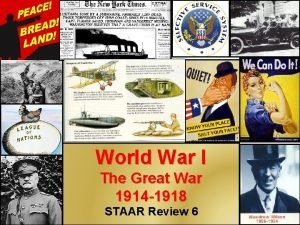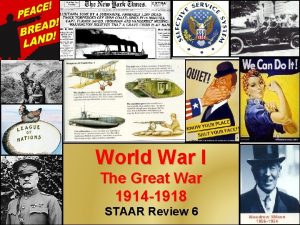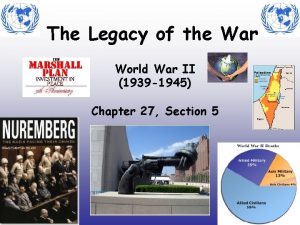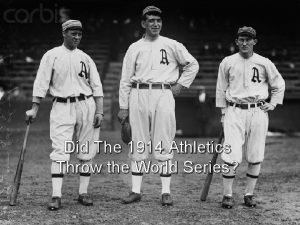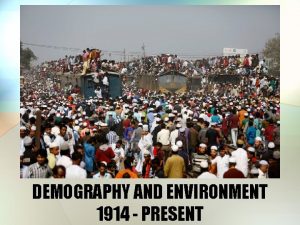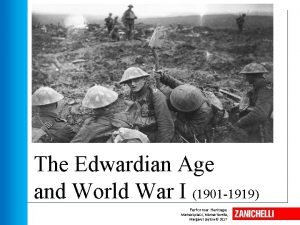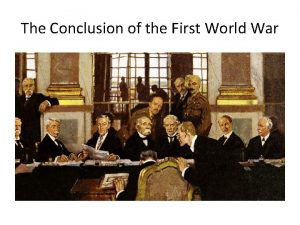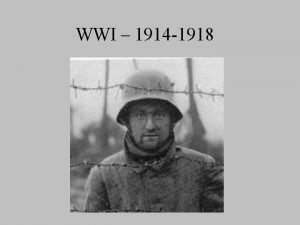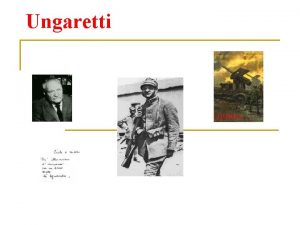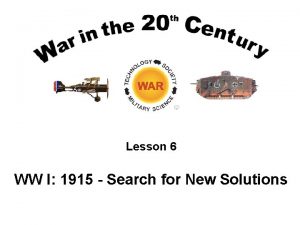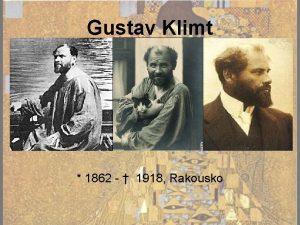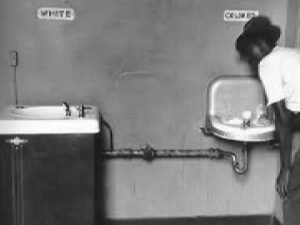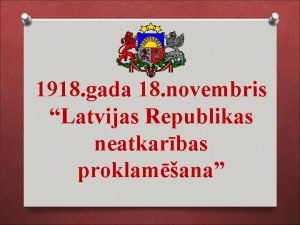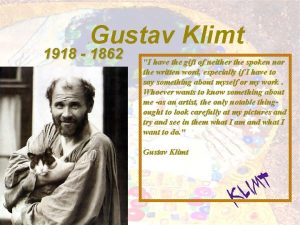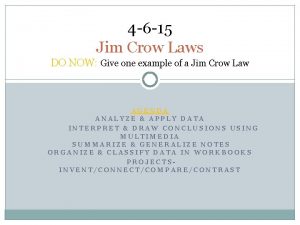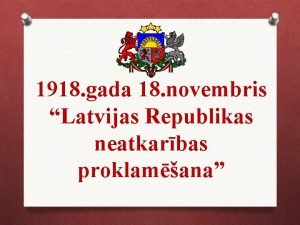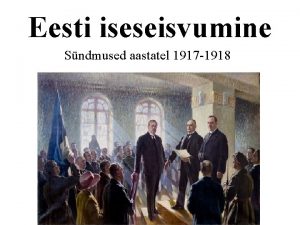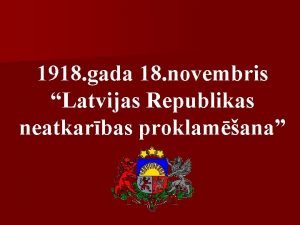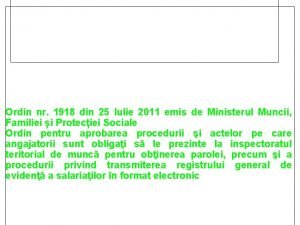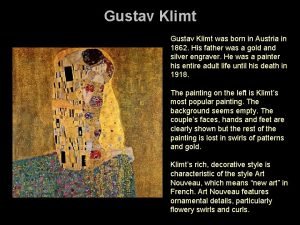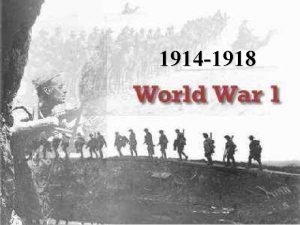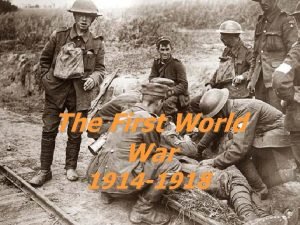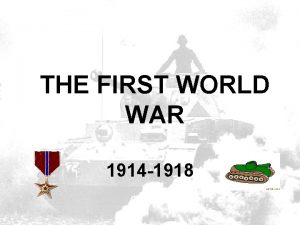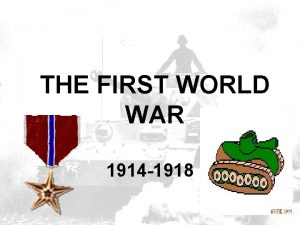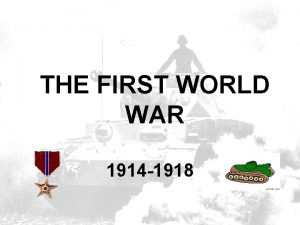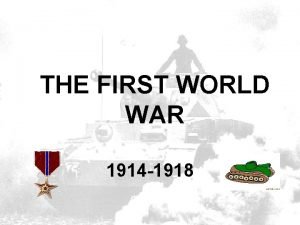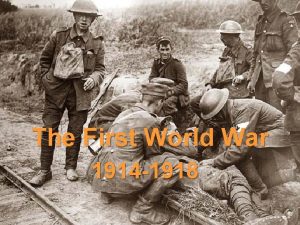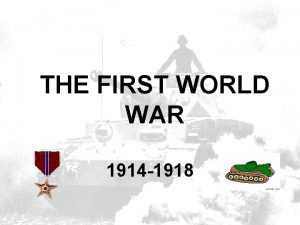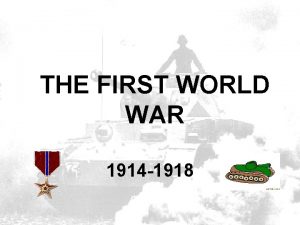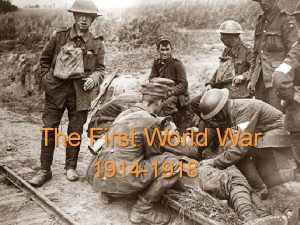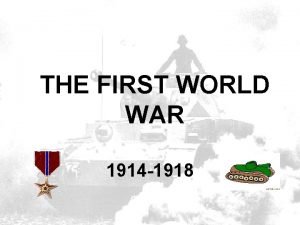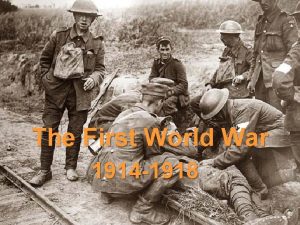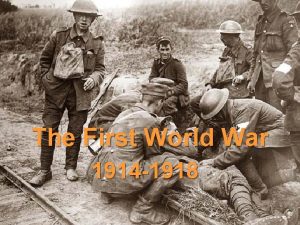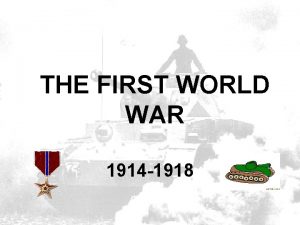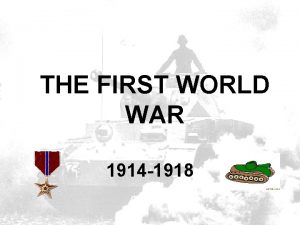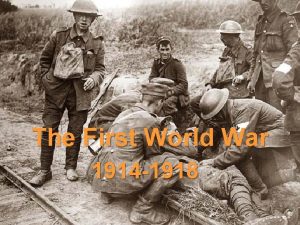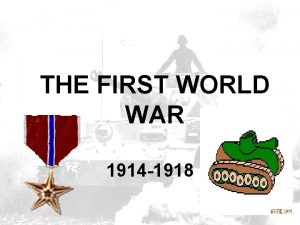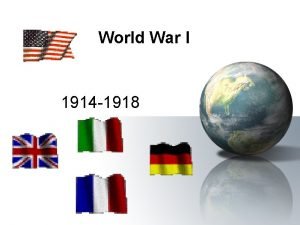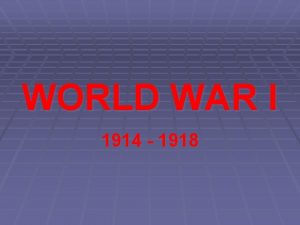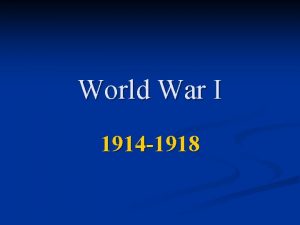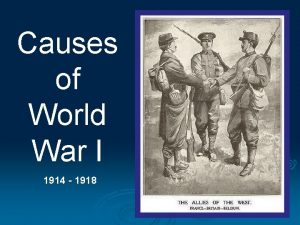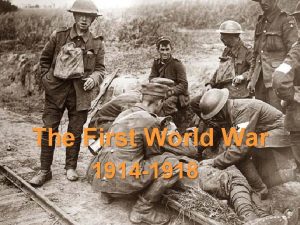THE FIRST WORLD WAR 1914 1918 CAUSES OF
















































- Slides: 48

THE FIRST WORLD WAR 1914 -1918

CAUSES OF THE WAR Historians have traditionally cited four long-term causes of the First World War ØNATIONALISM – a devotion to the interests and culture of one’s nation ØIMPERIALISM – Economic and political control over weaker nations ØMILITARISM – The growth of nationalism and imperialism led to increased military spending ØALLIANCE SYSTEM – By 1907 Europe was divided into two armed camps


ALLIANCE SYSTEM Ø By 1907 there were two major defense alliances in Europe TRIPLE ENTENTE Ø The Triple Entente, later known as the Allies, consisted of France, Britain, and Russia FRANCE BRITAIN RUSSIA ØThe Triple Alliance, later known as the Central Powers, consisted of Germany, Austria-Hungary, and Italy (Soon joined by the Ottoman Empire


THE SPARK: AN ASSASSINATION Ø The Balkan region was considered “the powder keg of Europe” due to competing interests in the area Ø Russia wanted access to the Mediterranean Sea Ø Germany wanted a rail link to the Ottoman Empire Ø Austria-Hungary, which had taken control of Bosnia in 1878, accused Serbia of subverting its rule over Bosnia Ø Finally, in June of 1914, Archduke Franz Ferdinand, heir to the Austrian throne was gunned down by a Serbia radical igniting a diplomatic crisis The Archduke is assassinated in Sarajevo in June 1914

THE WAR BECOMES A STALEMATE § Unable to save Belgium, the Allies retreated to the Marne River in France where they halted the German advance in September of 1914 § Both sides dug in for a long siege § By the spring of 1915, two parallel systems of deep trenches crossed France from Belgium to Switzerland § There were 3 types of trenches; front line, support, and reserve § Between enemy trenches was “no man’s land” – an area pockmarked with shell craters and filled with barbed wire British soldiers standing in mud

German Soldiers The conditions in these trenches were horrific; aside from the fear of bombardment, soldiers also had to contend with the mud, flooding and disease associated with living in such a harsh environment.

AMERICANS QUESTION NEUTRALITY Ø In 1914, most Americans saw no reason to join a struggle 3, 000 miles away – they wanted neutrality Ø Some simply did not want their sons to experience the horror of warfare Ø German-Americans supported Germany in World War I Ø However, many American felt close to the British because of a shared ancestry and language French propaganda poster portrayed the Germans as inhuman and impacted American attitudes toward the Germans Ø Most importantly, American economic interests were far stronger with the Allies

THE WAR HITS HOME Ø During the first two years of the war, America was providing (selling) the allied forces dynamite, cannon powder, submarines, copper wire and tubing and other war material Ø Both the Germans and British imposed naval blockades on each other German U-boat 1919 Ø The Germans used U-boats (submarines) to prevent shipments to the North Atlantic Ø Any ship found in the waters around Britain would be sunk

THE LUSITANIA DISASTER Ø United States involvement in World War I was hastened by the Lusitania disaster Ø The Lusitania was a British passenger liner that carried 1, 198 persons on a fateful trip on May 7, 1915 Ø A German U-boat sank the British passenger liner killing all aboard including 128 American tourists Ø The Germans claimed the ship was carrying Allied ammunition Ø Americans were outraged and public opinion turned against Germany and the Central Powers May 7, 1915

The N. Y. Times reports on the Lusitania

1916 ELECTION Ø The November 1916 election pitted obligatory Democrat Woodrow Wilson vs. Republican candidate Supreme Court justice Charles Evans Hughes Ø Wilson won a close election using the slogan, “He kept us out of war” Wilson Ø That slogan would prove ironic because within a few months the United States would be embroiled in World War I

AMERICA EDGES CLOSER TO WAR Several factors came together to bring the U. S. into the war; (Zimmerman note) Encoded message from Germany to Mexico Ø 1) Germany ignored Wilson’s plea for peace Ø 2) The Zimmerman Note, a telegram from the German foreign minister to the German Ambassador in Mexico, proposed an alliance Ø Germany promised Mexico a return of their “lost territory” in Texas, New Mexico, and Arizona Ø 3) Next came the sinking of four unarmed U. S. merchant ships by German subs

Zimmerman note intercepted by a British agent and decoded

AMERICA DECLARES WAR Ø A light drizzle fell on Washington on April 2, 1917, as senators, representatives, ambassadors, members of the Supreme Court, and other guests crowded into the Capital building to hear Wilson deliver his declaration of war Ø Wilson said, “The world must be safe for democracy” Ø Congress passed the resolution a few days later

AMERICAN POWER TIPS THE BALANCE Ø America was not ready for war – only 200, 000 men were in service when war was declared Ø Congress passed the Selective Service Act in May of 1917 Ø By the end of 1918, 24 million had signed up and almost 3 million were called to duty Ø About 2 million American troops reached Europe

FRESH U. S. SOLDIERS JOIN FIGHT Ø After 2 ½ years of fighting, the Allied forces were exhausted Ø One of the main contributions of the Americans was fresh and enthusiastic troops Ø American infantry were nicknamed “doughboys” because of their white belts Ø Most doughboys had never ventured far from the farms or small towns they lived in

NEW WEAPONS USED Ø Machine Guns – Guns could now fire 600 rounds per minute Ø The Tank – New steel tanks ran on caterpillar treads Ø Airplanes – Early dogfights resembled duals, however by 1918 the British had a fleet of planes that could deliver bomb loads Ø Poison Gas – mustard gas was used to subdue the enemy

Animals were also susceptible to gas

GERMANY COLLAPSES; COLLAPSES, THE GREAT WAR ENDS Ø On November 3, 1918, Germany’s partner, Austria. Hungary, surrendered to the Allies Ø That same day, German sailors mutinied against their government Ø Other revolts followed, and Germany was too exhausted to continue Ø So at the eleventh hour, on the eleventh day, of the eleventh month of 1918, Germany signed a truce ending the Great War ends 11/11/18

THE WAR AT HOME Ø The entire U. S. economy was focused on the war effort Ø The shift from a consumer economy to war economy required a collaboration between business and government Ø In the process, the power of the U. S. government expanded Ø Congress gave President Wilson direct control over the economy

WAR INDUSTRIES BOARD Ø The War Industries Board (WIB) encouraged companies to use mass-production techniques Ø Under the WIB, industrial production and wages increased 20% Ø Union membership almost doubled during the war years – from 2. 5 million to 4 million Ø To deal with disputes between management and labor, President Wilson set up the National War Labor Board in 1918 Poster encouraging production

Food Administration Ø To conserve food, Wilson set up the Food Administration (FA) Ø The FA declared one day a week “meatless” another “sweetless” and two days “wheatless” Ø Homeowners planted “victory gardens” in their yards Ø Schoolchildren worked afterschool growing tomatoes and cucumbers in public parks Ø Farmers increased production by almost 30% by adding 40 million acres of farmland

SELLING THE WAR Ø The U. S. had two major tasks; raising money and convincing the public to support the war Ø The U. S. spent $35. 5 billion on the war effort Ø The government raised about 1/3 of that through an income tax and “sin” taxes Ø The rest was raised through war bonds sold to the public (Liberty Loans & Victory Loans)

PROPAGANDA Ø To popularize the war, the government set up the nations first propaganda agency called the Committee on Public Information (CPI) Ø George Creel led the agency and persuaded many of the nation’s artists to create thousands of paintings, posters, cartoons and sculptures to promote the war













ATTACK ON CIVIL LIBERTIES Ø As the war progressed, Civil Liberties were compromised Ø Anti-Immigrant feelings were openly expressed especially anti-German and Austrian. Hungarian Ø Espionage and Sedition Acts were passed by Congress Ø These acts were designed to prevent anti-war protests but went against the spirit of the First Amendment (Free speech) Ø Socialists and labor leaders were targeted Any anti-American sentiments were targeted during wartime

SOCIAL CHANGE DURING THE WAR Ø The greatest effect of the First World War on the African American population was that it accelerated the Great Migration Ø The Great Migration was the large scale population shift for hundreds of thousands of blacks from the south to Northern cities This African American family settled in Chicago Ø They left to escape discrimination and to seek greater job opportunities Ø Popular destinations included Chicago, New York, Detroit, and Philadelphia

WOMEN IN THE WAR Ø Many women were called upon to take on jobs previously held by men who were serving in the war Ø They became railroad workers, cooks, dockworkers, factory workers, and miners Ø Many women served as volunteers in organizations such as the Red Cross Ø Their service hastened the passage of the 19 th Amendment in 1920 giving women the right to vote Rosie the Riveter was the symbol of women’s war contributions

SECTION 4: WILSON FIGHTS FOR PEACE Ø Despite the hero’s welcome he received in Europe, Wilson’s plan for peace would be rejected by the Allies Ø Wilson’s plan was called the “Fourteen points” Ø Included in his “points” were: ü No secret treaties ü Freedom of the Seas ü More free trade ü Reduction of arms ü Less colonialism ü League of Nations to promote peace Wilson’s 14 points in his own short hand

ALLIES REJECT WILSON”S PLAN, SIGN TREATY Ø The Big Four leaders, Wilson (U. S. ), Clemenceau (France), Lloyd George (England), and Orlando (Italy), worked out the Treaty’s details Ø Wilson conceded on most of his 14 points in return for the establishment of the League of Nations Ø On June 28, 1919, the Big Four and the leaders of the defeated nations gathered in the Hall of Mirrors at Versailles and signed the Treaty of Versailles Hall of Mirrors

TREATY OF VERSAILLES The Treaty established nine new nations including; Ø Poland, Czechoslovakia, and Yugoslavia Ø The Treaty broke up the Austro-Hungarian Empire and the Ottoman Empire empires Ø The Treaty barred Germany from maintaining an army, required them to give Alsace. Lorraine back to France, and forced them to pay $33 billion in reparations to the Allies The Big Four met at Versailles


THE WEAKNESS OF THE TREATY The harsh treatment of Germany prevented the Treaty from creating a lasting peace in Europe Ø The Treaty humiliated the Germans by forcing them to admit sole responsibility for the war (War-Guilt Clause) Germans felt the Versailles Treaty was unfair Ø Furthermore, Germany would never be able to pay $33 billion in reparations

DEBATE OVER TREATY AT HOME Ø In the United States, the Treaty was hotly debated especially the League of Nations Ø Conservative senators, headed by Henry Cabot Lodge, were suspicious of the Leagues’ joint economic and military commitments Ø Many wanted the U. S. Congress to maintain the right to declare war Ø Ultimately, Congress rejected U. S. involvement in the very League the U. S. President had created The U. S. never did join the league

THE LEGACY OF WWI Ø At home, the war strengthened both the military and the power of the government Ø The propaganda campaign provoked powerful fears in society Ø For many countries the war created political instability and violence that lasted for years Ø Russia established the first Communist state during the war WWI 1914 -1918 22 million dead, more than half civilians. An additional 20 million wounded. Ø Americans called World War I, “The War to end all Wars” --- however unresolved issues would eventually drag the U. S. into an even deadlier conflict
 1914 1918
1914 1918 Triple alliance
Triple alliance Who reorganized the war industries board in 1918
Who reorganized the war industries board in 1918 Causes of world war 2
Causes of world war 2 What caused world war 2
What caused world war 2 Long term causes of world war 1
Long term causes of world war 1 Main wwi
Main wwi What are the causes of world war 2
What are the causes of world war 2 Causes of world war 1 mania
Causes of world war 1 mania Causes of world war 1 mania
Causes of world war 1 mania Mania causes of ww1
Mania causes of ww1 Causes of ww2
Causes of ww2 Causes of world war 2
Causes of world war 2 Ww1 main causes
Ww1 main causes Major cause of ww1
Major cause of ww1 M.a.i.n. causes of ww1
M.a.i.n. causes of ww1 Causes of world war 2
Causes of world war 2 Pstuffy bunny
Pstuffy bunny Population of the world 1914
Population of the world 1914 Why was the civil war considered the first modern war
Why was the civil war considered the first modern war From the edwardian age to the first world war zanichelli
From the edwardian age to the first world war zanichelli Conclusion of world war 1
Conclusion of world war 1 Proximate vs ultimate causation
Proximate vs ultimate causation Altruistic acts examples
Altruistic acts examples Map of europe 1914
Map of europe 1914 Mapa ukrainy 1918
Mapa ukrainy 1918 Bosco di courton luogo
Bosco di courton luogo Varför kallas perioden 1918-1939 för mellankrigstiden
Varför kallas perioden 1918-1939 för mellankrigstiden 3.7 cm tak 1918
3.7 cm tak 1918 1918-1862
1918-1862 Jim crow character
Jim crow character 1918 18 novembris
1918 18 novembris Red scare
Red scare Georgia history timeline 1877-1919
Georgia history timeline 1877-1919 Proiect 1 decembrie 1918
Proiect 1 decembrie 1918 1918-1862
1918-1862 1918-1862
1918-1862 1918-1862
1918-1862 Louisiana 1918 poll tax receipt
Louisiana 1918 poll tax receipt 1918 18 novembris
1918 18 novembris 11 listopada 1918 piosenka tekst
11 listopada 1918 piosenka tekst 1918-1862
1918-1862 Veebruarirevolutsioon
Veebruarirevolutsioon 1918 18 novembris
1918 18 novembris Gustv
Gustv Palestina 1918
Palestina 1918 Revisal hg 500 din 2011 download
Revisal hg 500 din 2011 download Lịch sử hà nội từ năm 1802 đến năm 1918
Lịch sử hà nội từ năm 1802 đến năm 1918 1918-1862
1918-1862
